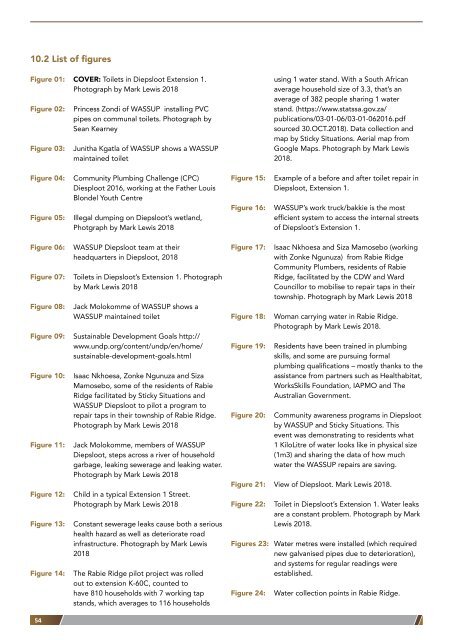WASSUP Diepsloot, Report March 2019
WASSUP Diepsloot: A proven grassroots program which prevents the loss of one billion litres of water per year in one extension of the Johannesburg township, where 39 households share one toilet.
WASSUP Diepsloot: A proven grassroots program which prevents the loss of one billion litres of water per year in one extension of the Johannesburg township, where 39 households share one toilet.
Create successful ePaper yourself
Turn your PDF publications into a flip-book with our unique Google optimized e-Paper software.
10 APPENDICES<br />
10.2 List of figures<br />
Figure 01: COVER: Toilets in <strong>Diepsloot</strong> Extension 1.<br />
Photograph by Mark Lewis 2018<br />
Figure 02:<br />
Figure 03:<br />
Figure 04:<br />
Figure 05:<br />
Figure 06:<br />
Figure 07:<br />
Figure 08:<br />
Figure 09:<br />
Figure 10:<br />
Figure 11:<br />
Figure 12:<br />
Figure 13:<br />
Figure 14:<br />
Princess Zondi of <strong>WASSUP</strong> installing PVC<br />
pipes on communal toilets. Photograph by<br />
Sean Kearney<br />
Junitha Kgatla of <strong>WASSUP</strong> shows a <strong>WASSUP</strong><br />
maintained toilet<br />
Community Plumbing Challenge (CPC)<br />
Diesploot 2016, working at the Father Louis<br />
Blondel Youth Centre<br />
Illegal dumping on <strong>Diepsloot</strong>’s wetland,<br />
Photgraph by Mark Lewis 2018<br />
<strong>WASSUP</strong> <strong>Diepsloot</strong> team at their<br />
headquarters in <strong>Diepsloot</strong>, 2018<br />
Toilets in <strong>Diepsloot</strong>’s Extension 1. Photograph<br />
by Mark Lewis 2018<br />
Jack Molokomme of <strong>WASSUP</strong> shows a<br />
<strong>WASSUP</strong> maintained toilet<br />
Sustainable Development Goals http://<br />
www.undp.org/content/undp/en/home/<br />
sustainable-development-goals.html<br />
Isaac Nkhoesa, Zonke Ngunuza and Siza<br />
Mamosebo, some of the residents of Rabie<br />
Ridge facilitated by Sticky Situations and<br />
<strong>WASSUP</strong> <strong>Diepsloot</strong> to pilot a program to<br />
repair taps in their township of Rabie Ridge.<br />
Photograph by Mark Lewis 2018<br />
Jack Molokomme, members of <strong>WASSUP</strong><br />
<strong>Diepsloot</strong>, steps across a river of household<br />
garbage, leaking sewerage and leaking water.<br />
Photograph by Mark Lewis 2018<br />
Child in a typical Extension 1 Street.<br />
Photograph by Mark Lewis 2018<br />
Constant sewerage leaks cause both a serious<br />
health hazard as well as deteriorate road<br />
infrastructure. Photograph by Mark Lewis<br />
2018<br />
The Rabie Ridge pilot project was rolled<br />
out to extension K-60C, counted to<br />
have 810 households with 7 working tap<br />
stands, which averages to 116 households<br />
Figure 15:<br />
Figure 16:<br />
Figure 17:<br />
Figure 18:<br />
Figure 19:<br />
Figure 20:<br />
using 1 water stand. With a South African<br />
average household size of 3.3, that’s an<br />
average of 382 people sharing 1 water<br />
stand. (https://www.statssa.gov.za/<br />
publications/03-01-06/03-01-062016.pdf<br />
sourced 30.OCT.2018). Data collection and<br />
map by Sticky Situations. Aerial map from<br />
Google Maps. Photograph by Mark Lewis<br />
2018.<br />
Example of a before and after toilet repair in<br />
<strong>Diepsloot</strong>, Extension 1.<br />
<strong>WASSUP</strong>’s work truck/bakkie is the most<br />
efficient system to access the internal streets<br />
of <strong>Diepsloot</strong>’s Extension 1.<br />
Isaac Nkhoesa and Siza Mamosebo (working<br />
with Zonke Ngunuza) from Rabie Ridge<br />
Community Plumbers, residents of Rabie<br />
Ridge, facilitated by the CDW and Ward<br />
Councillor to mobilise to repair taps in their<br />
township. Photograph by Mark Lewis 2018<br />
Woman carrying water in Rabie Ridge.<br />
Photograph by Mark Lewis 2018.<br />
Residents have been trained in plumbing<br />
skills, and some are pursuing formal<br />
plumbing qualifications – mostly thanks to the<br />
assistance from partners such as Healthabitat,<br />
WorksSkills Foundation, IAPMO and The<br />
Australian Government.<br />
Community awareness programs in <strong>Diepsloot</strong><br />
by <strong>WASSUP</strong> and Sticky Situations. This<br />
event was demonstrating to residents what<br />
1 KiloLitre of water looks like in physical size<br />
(1m3) and sharing the data of how much<br />
water the <strong>WASSUP</strong> repairs are saving.<br />
Figure 21: View of <strong>Diepsloot</strong>. Mark Lewis 2018.<br />
Figure 22:<br />
Toilet in <strong>Diepsloot</strong>’s Extension 1. Water leaks<br />
are a constant problem. Photograph by Mark<br />
Lewis 2018.<br />
Figures 23: Water metres were installed (which required<br />
new galvanised pipes due to deterioration),<br />
and systems for regular readings were<br />
established.<br />
Figure 24:<br />
Water collection points in Rabie Ridge.<br />
Figures 25: Systems developed for the <strong>WASSUP</strong><br />
program: Work flow diagram plus processes<br />
for reporting and responding. Background<br />
photo of Rabie Ridge street. Photograph by<br />
Mark Lewis 2018.<br />
Figure 26:<br />
Jack Molokomme of <strong>WASSUP</strong> repairing<br />
toilets in <strong>Diepsloot</strong>, Extension 1.<br />
Figure <strong>WASSUP</strong>’s administrator, Princess Zondi,<br />
27 & 28: manning the reporting counter where<br />
residents report emergency repairs<br />
Figure 29:<br />
Figure 30:<br />
Figure 31:<br />
Graph showing water use from control group<br />
of toilets and repaired group of toilets after<br />
42 days, showing an average difference of<br />
over 4,000 litres of water per day per toilet<br />
Graph showing water use from control group<br />
of toilets and repaired group of toilets after<br />
109 days, showing an average difference of<br />
3,600 litres of water per day per toilet. Note<br />
that in May 2014 the control group of toilets<br />
were upgraded which is why the red line<br />
comes down to similar water use levels of the<br />
green maintained toilets.<br />
This graph shows the water use over 4 years,<br />
demonstrating the average per toilet savings<br />
of 4,640litres of water per day. Note that the<br />
control toilets were upgraded in May/June<br />
2014 which lowered the water waste, but<br />
without repairs & maintenance the control<br />
group again increased in water wastage<br />
Figure 32: Leaking sewerage in <strong>Diepsloot</strong>’s Extension 1.<br />
Photograph by Mark Lewis 2018<br />
Figure 33: Toilet facilities in <strong>Diepsloot</strong>’s Extension 1.<br />
Water leaks are clearly visible. Photograph by<br />
Mark Lewis 2018<br />
Figure 34:<br />
Figure 35:<br />
Figure 36:<br />
An example of some key improvements<br />
from Survey + Fix <strong>March</strong> 2017 to July 2018,<br />
demonstrating that cyclical repairs reduce the<br />
ongoing workload.<br />
Child in Rabie Ridge<br />
Team USA at the 2016 Community Plumbing<br />
Challenge installing new toilet units.<br />
Figure Partnerships have been key to <strong>WASSUP</strong>s<br />
37-38: success, pictured left and above with the<br />
IAPMO Community Plumbing Challenge<br />
(CPC) program with Team USA and Team<br />
Figure 39:<br />
INDIA installing new toilet blocks in 2016.<br />
The CPC program, along with longer-term<br />
partnerships with international plumbing<br />
organisations, gave a real boost to the<br />
<strong>Diepsloot</strong> program<br />
The City of Joburg ran a MineCraft public<br />
space design program in partnership with<br />
UN-Habitat Global Public Space Programme.<br />
By aligning multiple projects related to public<br />
space and public amenities projects can go<br />
much futher than by operating independantly<br />
Figures 40: Some other partnerships (Johannesburg<br />
Development Agency, Smithsonian Exhibition<br />
‘Design With the other 90%’, Anna Rubbo<br />
from The Global Studio, Anne Fitchett<br />
from University of the Witwatersrand, Paul<br />
Pholeros from Healthabitat, Australian<br />
Embassy visitors and Community Plumbing<br />
Challenge 2016<br />
Figure 41: Toilets in Extension 1, <strong>Diepsloot</strong>. CPC 2016<br />
planning site visit. Photograph by Sean<br />
Kearney<br />
Figure 42: Failed infrastructure in <strong>Diepsloot</strong> Extension 1.<br />
Photograph by Mark Lewis<br />
Figure 43:<br />
Figure 44:<br />
Figure 45:<br />
Water leaks running through <strong>Diepsloot</strong><br />
Extension 1. Photograph by Mark Lewis<br />
Household waste in Extension 1 <strong>Diepsloot</strong><br />
Young girl collecting water in Rabie Ridge<br />
Figure <strong>WASSUP</strong> team members repairing toilets<br />
46-47: and collecting data.<br />
Figure 48:<br />
Woman washing in <strong>Diepsloot</strong><br />
Figure 49: Trading stall in <strong>Diepsloot</strong> Extension 1.<br />
Figure 50: Household waste in <strong>Diepsloot</strong> Extension 1.<br />
Figure 51:<br />
Figure 52:<br />
Figure 53:<br />
Toilets in Rabie Ridge. Photograph by Mark<br />
Lewis 218.<br />
Artwork on <strong>Diepsloot</strong> Toilets by <strong>Diepsloot</strong><br />
Arts & Culture Network, 2016.<br />
BACK COVER: Reparing toilets during CPC<br />
2016. Photograph by Sean Kearney.<br />
54<br />
55








